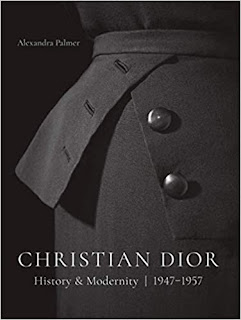Because of lockdowns and travel restrictions I was unable to go to an exhibition I particularly wanted to see this year. Happily, I was still able to buy the book which accompanied the exhibition!
Mary Quant (by Jenny Lister, with contributions by Johanna Agerman Ross, Beatrice Behlen, Regina Lee Blaszczyk, Susanna Brown, Elisabeth Murray, Janine Sykes and Stephanie Wood) was written to coincide with an exhibition held at the Victoria and Albert Museum between April 2019 and February 2020. It moved to Bendigo Art Gallery in Victoria in 2021, which is where I would have seen it if I'd been able to travel.
Mary Quant needs no introduction: she was most famous designer to come out of Swinging London. In fact she could be said to have inspired the entire look of the era. Though she began her career in fashion design in the late 1950s and continued working in the field until the early 1970s, her name is almost synonymous with the 1960s. Any pop-cultural history of the decade will have to give at least a
mention to the originator of the "Chelsea look" and one of the creators
of the miniskirt!
Jenny Lister follows Quant's career from her early days running a boutique in Chelsea through to her later years as a "lifestyle brand". Quant did not originally set out to design clothes. She sold other people's designs in Bazaar: "clothes and accessories ... sweaters, scarves, shifts, hats, jewellery and peculiar odds and ends" creating a look that was more modern and youthful than the styles then prevailing in post-war Britain.
When she did dip a toe into design, she began by adapting Butterick patterns and making up the garments herself using fabric purchased from Harrods! From these amateurish beginnings Quant eventually had her clothes made by a small factory, which in turn lead to the development of "Mary Quant's Ginger Group" and a deal in the U.S. with JC Penney. In the late sixties she began selling fashion accessories and makeup, all branded with her daisy logo. Her last collection for her Ginger Group was in 1975 and her business subsequently concentrated on licensing cosmetics, tights and furnishings.
While Jenny Lister follows Mary Quant's career chronologically, the other authors of this book contribute essays exploring tangential aspects of her work in depth. Thus Stephanie Wood contributes a chapter on the women who modelled her clothes, Susanna Brown one on how they were photographed. Regina Lee Blaszczyk explores Quant's business dealings in America. Beatrice Behlen discusses the history of Quant's cosmetic range—"young, no nonsense, problem-solving and easy to use". Janine Sykes dives into how the range was marketed, and Johanna Agernon Ross contributes a chapter on Quant's ventures into interior design.
So much for the text. However this book accompanied an exhibition, so what about the pictures? Well, besides many excellent contemporary illustrations and photographs, this book contains some excellent pictures of Mary Quant's clothes held in the V&A. Many of garments were donated specifically for this exhibition as the museum
"in June 2018 invited the the public to lend or donate specific garments as designed by Quant to enable the Museum to represent a more comprehensive range of her designs... Each of these garments is enhanced with details about the original wearer and their social background, why Mary Quant designs were specially chosen at the time, and the reasons for treasuring the garments for so long. Over 1,000 people responded offering Quant cosmetics and other memorabilia, some contributing photographs of Quant garments being worn at this time."
There isn't room to squeeze all the stories and photos contributed into this volume, but those that have made it into the book certainly make it a little bit special!
Mary Quant by Jenny Lister
ISBN 9781851779956
London: V&A Publishing, 2019




















































